 |
| Category: Flags |

|
|
|
|
|
|
The Boxing Kangaroo: an
Australian icon becomes a flag |
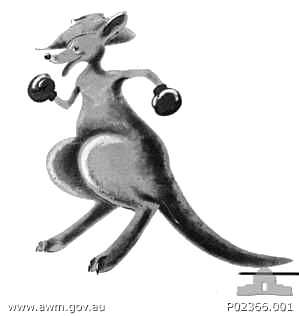 |
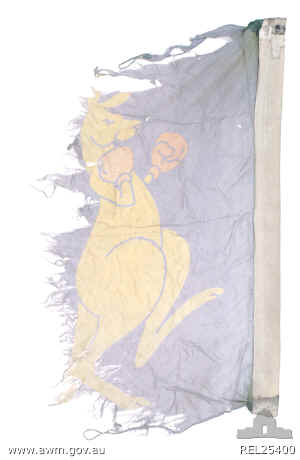 |
| Agra,
India, c. 1943-04. A sign featuring a boxing kangaroo wearing a slouch
hat is painted on the nose of a RAF Consolidated Liberator B-24 bomber
aircraft flown by a RAAF crew. The paint used in this example of nose
art was of a very light (desert) variety. (Donor R. Lichty) |
Frayed
grey and yellow coloured remnant of a nylon boxing kangaroo flag.
Manufacturer's label reads, 'APPROVED ORIGINAL DESIGN AMERICA'S CUP
CHALLENGE 1983 LTD.'. Used by members of the Australian Army involved in
mine clearance in Afghanistan with UNMCTT |
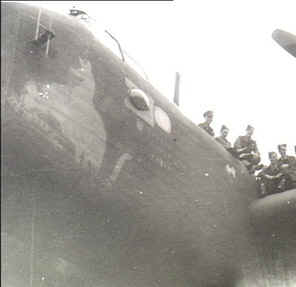 |
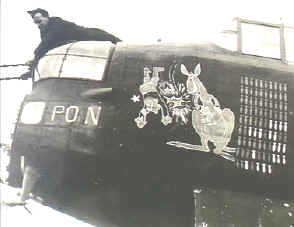 |
| Keevil,
England. 1944-09. Informal portrait of an aircrew of No. 196 Squadron
RAF, seated on their Stirling IV aircraft (20-Z). The squadron was with
the Allied Expeditionary Air Force towing Horsa gliders and dropping
paratroops at this time. Note the nose art of a boxing kangaroo and the
inscription `It's in the bag' and the tally of eighteen bombs (each one
representing a successful raid) behind the kangaroo's tail. (Donor C.
King) |
Lincolnshire,
England. 1944-12-06. "N" for Nuts, a Lancaster bomber aircraft
of No. 463 Squadron RAAF at RAF Station Waddington, which has completed
ninety four operations.
The white bombs represent daylight
raids. Its insignia shows the boxing kangaroo, with a joey in pouch,
"zamming" Adolph Hitler. |
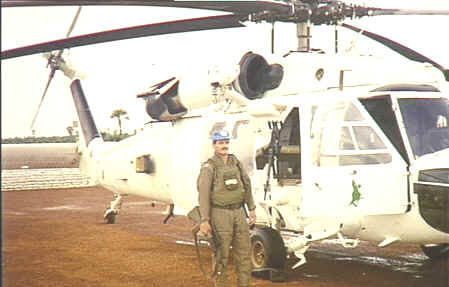 |
Battambang, Cambodia,
1993-06.
282019 Major Mark H. Sedsman, a
member of the Army Aviation Corps and Commanding Officer of the
Australian Contingent Aviation Group, United Nations Transitional
Authority in Cambodia (UNTAC), standing next to one of the Group's
Sikorsky S70A-9 Black Hawk helicopters. |
| Major
Sedsman is about to board the aircraft for an operational sortie to
Stung Treng east of the Mekong River, passing over the Angkor Wat temple
complex near Siem Reap. He is wearing the standard dress and is carrying
the standard equipment for flying missions. These include a
fire-resistant flying suit, protective body armour made of ceramic
plate, a 5.56mm Steyr AUG rifle and a 9mm Browning self-loading pistol
(not in view). He is also wearing a blue United Nations (UN) cap.
Mounted in the doorway of the helicopter is a MAG58 7.62mm machine gun
which was manned by the aircraft's loadmaster. The helicopter is painted
in the white of the UN, while its door bears an icon of a boxing
kangaroo, a distinguishing feature
that became well known to the soldiers of many nationalities who
travelled in the aircraft. (Donor M. Sedsman). AWM PO1837.002 |
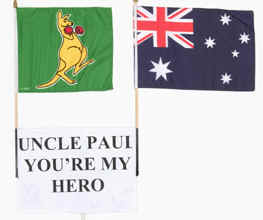 |
Welcome home
banner prepared for Lieutenant Commander Paul Moggach, RAN, flight
commander and senior pilot of HMAS Kanimbla's embarked Westland Sea King
helicopter during the war on Iraq, 2003.
The helicopter, N16-118, callsign
'Shark 07', flew a record 162.5 operational hours during March 2003,
carrying 200 000 pounds of stores and 326 passengers as well as
conducting two medical evacuations.
'Shark 07' was the first RAN aircraft
to land in Iraq following the commencement of hostilities. |
| The amphibious transport
HMAS Kanimbla (LPA-51) was acquired by the Royal Australian Navy from
the US Navy in 1994 for use as a helicopter support and sea training
vessel. During 2003, while participating in Maritime Interception
Operations in the Persian Gulf and in the war on Iraq, Kanimbla served
as command and control platform for the Australian Task Group. Coalition
boarding operations were coordinated from Kanimbla. At one point the
ship hosted boarding teams and inflatable boats from three different
countries, and a total of 88 sea mines were intercepted. |
|
Boxing Kangaroo Flag |
![[Boxing kangaroo flag]](../images/uniforms3/roo1.gif) |
- The Boxing Kangaroo flag was
designed by an Air Force Warrant Officer. He based his idea on the
design he saw on a travelling boxing show which had kangaroos boxing
with men.
- During 1941 the boxing kangaroos
were stencilled on Australian Wirraway fighters based in Singapore.
|
![[Boxing Kangaroo flag with southern cross]](../images/uniforms3/roo2.gif) |
- Variation with Southern Cross.
|
| The Boxing Kangaroo
has long been accepted as a symbol of Australia, certainly by the
Australians if not the rest of the world. The design is attributed, by
official RAAF
history, to Warrant Officer Gus Bluett and is based on recorded,
including film archives, 19th century travelling side-show
entertainment, when the sport of boxing contests between men and kangaroos
were a reality.
More details about how this subject evolved over years can be found on Bigger better beards.
It was in 1941 during World War II
that the design first found national acceptance when RAAF pilots based
at Sembawang Station in Singapore, forming 21 Squadron, had a stencilled
boxing kangaroo painted on the side of their Wirraway fighter planes, by
aircraftman David Marfleet, to identify themselves to the Japanese as
Australian and not British.
The flag became famous to younger
Australians when Australia II won the America's Cup in yachting in 1983.
The Boxing Kangaroo was used by the owner of the team, Alan Bond, as the
flag on the yacht entering and leaving harbor. The Australian Olympic
Commission (AOC) purchased the rights to the Boxing Kangaroo for the
Sydney Olympic Games in 2000, for 13 million dollars, and it was popular
with pin traders. |
|
Details of the Kangaroo |
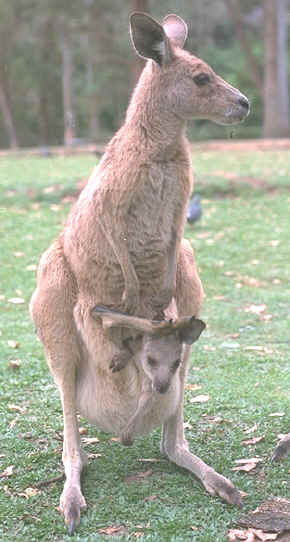 |
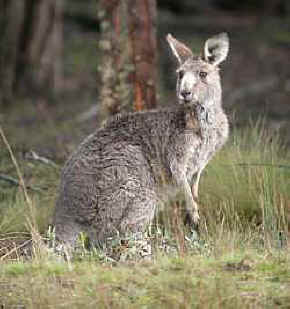
Kangaroos
are the largest of the marsupials. Like other large macropods (macropod
means big foot) their hind limbs are very large, much bigger than the
forelimbs which are short and lightly built. The tail is long and
muscular.
|
| There are six main species of kangaroos:
Common, Black and Antilopine Wallaroos, Eastern and Western Grey kangaroo
and the Red kangaroo.
The Red
Kangaroo, the largest of all kangaroos, can weigh up to 90kg and grow to
1.8 metres high (some reach over 2m when in a fighting stance).
At full speed they have been known to
cover a distance of 8m effortlessly in one leap. They spend a large part
of the day lying in the shade and are most active in early morning and
late evening (after sunset).
Description Kangaroos
have narrow hands with forward focussing eyes. This provides a wide field
of vision. Large and erect ears rotate separately listening constantly to
their surroundings. Both sexes have slender chests with the male
developing very muscular biceps and forearms. Forepaws are hand like and
used for fighting, grooming and holding food.
Powerful hind limbs and large feet
enable the kangaroo to bound at great speeds across open ground. Their
long muscular tail moves up and down like a pump handle to counter balance
the body. While grazing or slowly bipedal walking, the tail is used as a
fifth limb to support the body while the hind legs are swung forward
together. When grooming the tail is used as a prop and may be the only
limb touching the ground when fighting.
The fourth toe is highly developed with
a strong nail. The second and third toes are fused together except for the
claws. These toes are called syndactylous and are used for grooming.
Breeding Kangaroos
breed throughout the year. Newly born young, known as joeys, weigh less
than 1 gram and make their way into the pouch unassisted by their mother.
The pouch contains four mammary glands, of which two at a time are
functional, and the joey will remain in the pouch until it is 5 – 9
months old. The female will mate again after giving birth but the embryo
doesn’t develop until the first joey leaves the pouch. The joey emerges
permanently from about 10 months and then stays with its mother,
continuing to suckle by placing its head in her pouch until it is 12 –
18 months old.
Diet Kangaroos
are grazers of low nutritional, high fibre grasses. The forestomach houses
micro-organisms which assist in the digestion of a diet high in cellulose.
Kangaroos need little water except in drought. They obtain most of their
moisture from dew covered grass and leaves as well as moisture from green
grasses and plants.
Habitat Kangaroos
can be found to occupy areas right across the continent. Certain species
prefer certain areas:
Reds: Widespread, semi-arid plains of
the interior.
Greys: Inhabit forested country feeding
on the open grasslands of Eastern Australia to South Western Australia.
Wallaroos: Widespread from grasslands to
coastal forests and on hilly escarpments where ledges and caves provide
shelter.
Threats Man,
dingoes, goannas, pythons, eagles, feral and domestic dogs and foxes are
predators of kangaroos. Kangaroos also get into trouble from motor
vehicle collisions, shootings, animal attacks, fence entanglement and
being orphaned. |
|